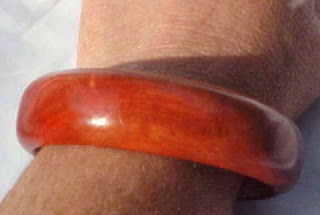| As quoted from the Exotic Wood Group, Pictures of Cuff by JewelrybyJanelle Procuring Pink Ivory wood (Rhamnus zeyheri) these days is a lot easier than it used to be. Known as the "royal wood" of the Zulus, only full-fledged members of the Zulu Kingdom's royal family were officially allowed to possess it back in the 1800s. To drive home the idea of this exclusivity — as well as to increase demand abroad — some unknown, 19th-century marketing guru spread the rumor that any non-royal entity (foreigners included) found in possession of Pink Ivory would face the death penalty. Naturally, the wood has been highly sought after by woodworkers around the world ever since. (Nothing sells like the threat of capital punishment!) Very likely, this is why this wood was once said to be rarer than diamonds. Pink Ivory is especially favored nowadays by wood carvers and turners, and is typically used to make smaller-sized items such as jewelry pieces, bowls, pool cue butts, chess pieces, golf putters, knife handles, and game calls; it is also popular for inlay and marquetry work. Pink Ivory blanks are usually on the narrower side because the trees — found predominantly in South Africa, Zimbabwe, and Mozambique — rarely produce trunks wider than a foot in diameter (the trees reach heights of about 20 to 40 feet). Special permits are required to harvest the wood. | ||
| The startling color of Pink Ivory is produced by bands of tissue in the wood's growth rings. The heartwood ranges in color from a faint, light pink to a vibrant, almost red. The sapwood is yellowish. Pink Ivory blanks are divided into three categories — Regular, Select, and Premium — based on the richness of the color. It should be noted that, like many beautiful things in life, the attractiveness of Pink Ivory can be somewhat fleeting. Over time, the pink color tends to become a duller, brownish shade. How long this process takes depends on the particular piece of wood and how much it's exposed to sunlight. Pink Ivory wood is very hard and dense, with an average specific gravity of about 0.90. It carves and turns well, although sharp tools are essential. The wood also polishes nicely. These cuffs are labor and material intensive, which is all figured into the cost of my cuffs, as well as the cost of the wood. I do not yet know how to use a lathe, so they are shaped on a belt sander using four different grits of sandpaper, 80, 120, 150, and 180. I then hand sand, with even finer grits of 220, 400, and sometimes as fine as 600 grit, depending on the density of the particular wood I am working. For the finish, I use only oils, usually Danish or Teak, manufactured by Watco, (a highly recommended oil that runs about $9 per pint). depending largely on the coloring of the wood. This one was finished in Danish oil, which doesn't darken the coloring of the wood, in fact, quite the opposite, it makes the color pop and the figure just jump out at you. The cuff has to soak for at least 1 hour and 30 minutes, and the wood soaks up its share of the oil. Then I allow it to cure for at least 24 hours. An oil finish serves to harden the wood for durability, and appearance when buffing. The oil gives the finish, when buffed, a satiny up to a high, glossy, glassy shine, whichever is preferred. | ||
Friday, April 23, 2010
Pink Ivory-Once Said to Be Rarer Than Diamonds
Subscribe to:
Post Comments (Atom)











No comments:
Post a Comment